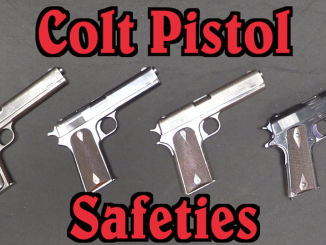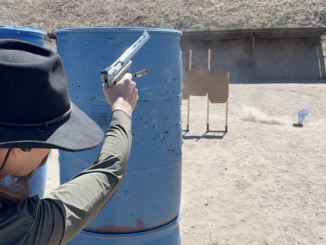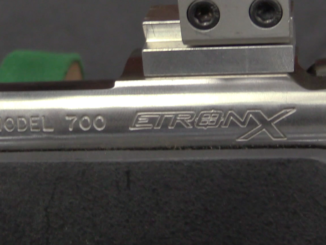Dan Coonan first designed his pistol in graduate school as a drafting project: a 1911 pistol chambered for the .357 Magnum cartridge. No easy feat, designing a self-loading pistol magazine to cycle a big rimmed revolver cartridge! This was in 1977, and he went about creating a business to manufacture them a few years later with the first guns available in 1983. The company lasted until 1998, and then a new firm (Coonan Inc) was reformed in 2009 and lasted again until 2019.
The Coonan .357 Magnum Automatic is essentially just a 1911 pistol stretched for the new cartridge, but there are a number of more subtle design changes made to improve its reliability, accuracy, and manufacturability. An external extractor was used, and shortly after production began the barrel link was replaced by a fixed cam (like the High Power). Today the guns are out of production (total production was something like 10,000 examples), but have a reputation for excellent accuracy and reliability, belying the difficulty of their core design.




Ruger doesn’t get (in my opinion) enough credit for their work in high-quality castings. Back in the 1980s they were casting aluminium frames for their P series pistols (P-85, P-89, etc.) that work perfectly and have lasted many decades so far.
Some people may know that Ruger’s casting ability led to their making the “Big Bertha” golf clubs for Calloway in the 1990s, from cast titanium. (Hammers also, I believe.) See their subsidiary: Pine Tree Castings https://ruger.com/casting/PDF/PineTreeCastings.pdf
The only thing I don’t like about Forgotten Weapons is this continual desire for discontinued weapons it brings about in me. I was too poor to consider a Coonan when they were in production, but learning that the gun would also shoot .38 special makes me really, REALLY want one.
“(…)gun would also shoot .38 special makes me really,(…)”
Strictly speaking either, as https://modernfirearms.net/en/handguns/handguns-en/u-s-a-semi-automatic-pistols/coonan-eng/ puts its
Coonan arms also offered .38 Special +P caliber conversion kits, which included weaker return springs and magazines with spacers, which were necessary to firmly hold shorter rounds.
So it was impossible to mix .357 and .38 as if in revolver.
If .357 is too common for you, then there apparently was .41 version
During early 1990’s Coonan introduced a cut-down “Cadet” model with shortened barrel and grip; at about the same time he also worked on .41 Magnum caliber pistol, which apparently was never finished.
I almost bought one in 1988 as the Federal Agency I was working for would have let me carry it. I wished I had.
This pistol harkens back to the styling of the 1905 Colt Automatic which I like very much. Closest I can find to the 1905 in ergonomics is the TT 33.
lol @ that grip
Well… revolvers and automatic pistols evolved mostly separately from each other, so when trying to meld these might give… funky results aesthetic-wise, see VBR GP https://guns.fandom.com/wiki/VBR_GP
great find!
I wonder if there exist revolver with normal pistol shape grip
“total production was something like 10,000 examples”
That is 2 order magnitude greater than Union automatic pistol
https://guns.fandom.com/wiki/Union_automatic_pistol
made in dawn of 20th century and firing .32 S&W cartridge.
Met Dan Coonan a couple of times, a nice fellow, and it’s a shame the gun wasn’t more successful. I’ve seen one shot at a local steel match, and other than the noise, I couldn’t tell it was a Magnum round, reliability wise.
I also have a white Coonan Magnum Automatic meshback ballcap I found at a sale, new old stock. If anyone would like it (Ian gets first crack) we can arrange it.
Very impressive piece of work by Mr. Coonan. However, it should be pointed out that the rimmed cartridge in straight box magazine was not a ‘mission impossible’ to begin with. As Ian pointed out, there are many 22cal. box magazines which work with up to 10-12 rounds quite well. Also, there are magazines for 12 gauge shotshells (most notably Saiga) and last but not the least the Dragunov rifle magazine for 7.62x54R. They all work superbly well.
It is not a surprise that the attractiveness of .357 Coonan has faded in light of 10mm Auto. The gun production was remarkably long though.
7,62 x 54 R as opposed to .357 Magnum is bottle-necked so I would be cautious with comparison.
There existed earlier some sporting pistols for rimmed cartridge – Walther GSP (.32 version) and Gold Cup National Match https://revivaler.com/colt-m1911-gold-cup-national-match-38-special/ (.38 Special)
On the subject of cast frame. There was a pioneering work done by Para Ordnance in Scarborough, Ontario which came in 1990s with 9mm version of M1911 and with 14round magazine. Later entire line was created around the concept. Its frame was investment cast.
The company happen to have extensive experience in building tooling/ moulds for that kind of work. It is a logical way to address the issue of frame production; cutting frame out of billet as on GP35 is a way of distant past.
.41 Magnum not a .422 ie 44. Desert Eagle and Ruger Black Hawk, if only a Coonan in 41 tis but to dream
I would argue that what really killed the Coonan, other than cost and the ergonomics of a carpenter’s square, was the fact that ballistically it gave no better performance than a 3.5″ .357 revolver. Because once you subtract the 1.29″ chamber length from the 5″ barrel, that’s about how much barrel you have left; 3.71 inches to be exact.
It was bigger and heavier than a 4″ medium frame .357, less “user-friendly”, and a lot more expensive.
What really killed it was the advent of 9x 19mm +P and +P+ ammunition, which could pretty much duplicate .357 125-gr. JHP performance in a 9 x 19mm service pistol. Weighing less, costing less, and having greater magazine capacity.
When I saw what a Coonan weighed, how much it cost, and etc., I shrugged and bought a couple of more boxes of Speer 124-grain JHP for my issue Beretta M92FS.
cheers
eon
Other things which might affect that: popularity of .357 SIG cartridge, .357 revolvers holding more than 6 rounds like S&W Model 686P (7 rounds) or Taurus Model 608 (8 rounds)
The .357 SiG round has always been pretty much a “niche” cartridge. The FBI adopted it briefly, but in the end found that like the .40 S&W it was based on it gave no real advantage over the 9 x 19mm and reduced magazine capacity. (The U.S. Marshal Service still uses Glocks in .40 S&W, God only knows why.)
“Eight-shooter” .357s on the S&W planform always have the same problem that small-frame 6-shot .357s on the S&W planform have. Namely that over time, the locking pawl recesses, which are right over the thinnest part of each chamber wall, become dimpled by firing pressure, eventually causing extraction problems, if not something worse.
The large-frame eight-shots have less steel thickness at those points than the small-frame six-shots do, so I would not be surprised to see “broken through” pawl notches much like those common on the early “twelve-notch” Colt 1860/1872 Richards/Mason metallic cartridge .44 Colt conversion revolvers. There’s a reason Colt abandoned that idea.
For a S&W type revolver in magnum calibers, unless it’s something like an N-frame M27 or M28 .357 which has plenty of steel thickness in that bi8g cylinder, you really want an odd number of chambers, five, seven, etc.
That puts the locking pawl notches in the triangular webs of steel between the chambers, eliminating the “dimpling” problem and potential trouble later on.
Due to the cylinder rotating the “opposite way”, Colt revolvers with six chambers and only six notches never had this problem because the notches are offset to one side of each chamber. Which is how Colt got away with the original Magnum Carry, a Detective Special in .357, one of the very nice revolvers those dimwits no longer make, along with the original King Cobra (an affordable Python). The present-day “King Cobra” is really just a cheap knockoff Magnum Carry at an inflated price.
What all of this did, and does, is avoid dealing with the real issue, namely that we need 9mms with “straight” cases that have .357 muzzle energy. The logical answer is the old 9 x 25mm Mauser Export, or else the very similar 9mm Winchester Magnum. Both deliver about 550 FPE at the muzzle with a 124 grain bullet. Load them with modern JHPs and put them in something like a Glock or SiG high-capacity auto, and you have very nearly the ideal police service pistol.
I do not approve of the 9 x 23 Winchester (not the same case as 9mm WM). It can chamber and fire in .38 ACP, .38 Super, and 9 x 23mm Bergmann-Bayard aka 9mm Largo-chambered pistols. And likely blow them up.
cheers
eon
Don’t underestimate the .357 Magnum
According to Balistics By The Inch (ballisticsbytheinch.com)
The .357 Magnum from a 3.5 inch Barrel produces about 500 ftlbf of force at the Barrel.
The hottest 9mm listed requires a 6 inch Barrel to achieve the same energy and only produces about 420 ftlbf from a 3.5 Inch Barrel.
The flaw in BBTI testing is all barrels were measured from the test Barrel breach face like semi-automatic pistols. Therefore you should use the data for the 5 inch .357 Magnum results which produced about 750 ftlbf.
The maximum energy produced from the 9mm (out to an 18 inch Barrel) was only about 620 ftlbsf.
Not that it matters much in this discussion, but at that length the .357 Magnum putsout 1200 ftlbf.
I have a Coonan and also several S&W model 27s and a 4″ 8 shot 627 and have run rounds over the chrono from the Coonan and all the N frame 357s. The Coonan clocks quite a bit higher than a 4″ S&W and that’s primarily due to being a closed chamber vs an open chamber (barrel/cylinder gap). The Coonan is more comparable to a 6″ or 6 1/2″ barrel N frame. My biggest gripe about the Coonan isn’t the weight (roughly comparable to a 1911 or N frame Smith), but rather it launches the fired cases 40-50 feet with good 357 Mag ammo. Since I reload, this is a definite disadvantage since it’s fairly easy to lose a sizable majority of the fired cases. It is a fun gun to shoot though and the fire rings are an attention grabber on the firing line.
What do you think about box magazines(their reliability etc.) that are more or less double stack from rim side and (again – more or less) single stack from bullet tip side?
Some of them were mentioned above.
Ian, you said the standard 1911 trigger is harder to fine tune. Really? I think every 1911 gunsmith is going to disagree with you om that one.
The most difficult trigger to tune is that of the P35 High Power. The 1911 is a breeze to polish compared to it.
Being an HP user myself, if a P35 has a pull of between five and seven pounds I strongly recommend not fooling with it.
cheers
eon
I remember reading the Guns and Ammo review of the Coonan and then of the LAR back in about ’83 – ’84 time.
There appears to be a lot of attention to detail on the design and execution.
It’s excellent that Coonan was able to help with the history
The absence of the additional shaping at the front of the slide, might have a simple explanation
It makes the slide a lot easier to finish
All it needs is a touch up on a linisher.
Swapping the mainspring to shoot .38 Special?
I do believe that’s the recoil spring, not the mainspring.
Now I am extremely confused, what does need replacement for .38 Special
– mainspring
xor
– recoil spring as postulated by KBCraig
xor
– return springs as claims https://modernfirearms.net/en/handguns/handguns-en/u-s-a-semi-automatic-pistols/coonan-eng/
?
I am lucky enough to have two Coonan 357’s consecutively serial numbered that I got about five years before they tanked. I also have a FN-FAL built by ARS on a Coonan (one of the good ones…). I’ve only put test rounds down one 357 and both are as new in the Coonan cases. No idea what they’d be worth today but none are for sale. VERY accurate well made pistols. I, sure my grandson will appreciate them?